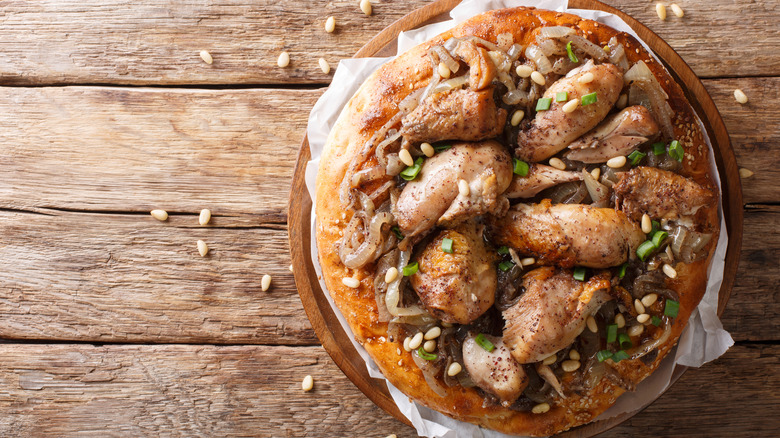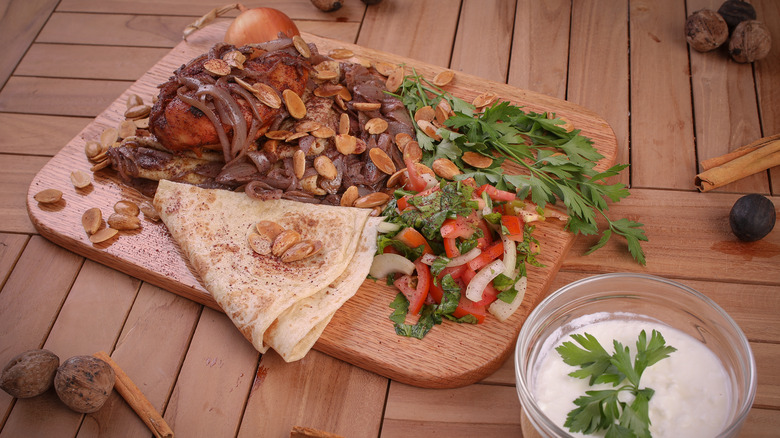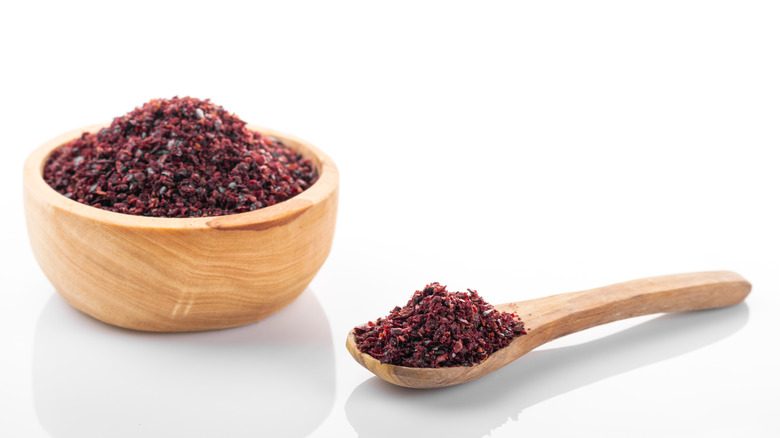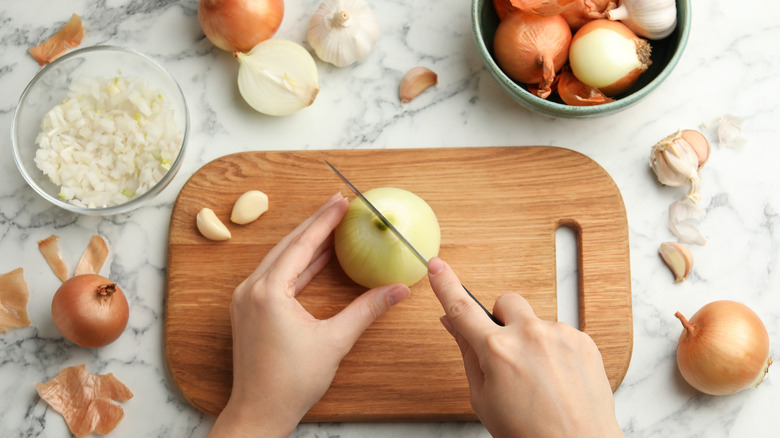Musakhan: The Palestinian Chicken Flatbread You Should Know
Palestinian cuisine lies under the umbrella of Middle Eastern cuisine. Palestinian cuisine has a range of delicacies that highlight olive oil, fish, yogurt, and legumes (as per Welcome to Palestine).
No matter what you dine on, you're bound to taste garlicky and herbaceous notes that pair exceedingly well with sumac and za'atar (via BBC Good Food and Outlook Traveller). There may be some slight variances though, depending on which area you're in.
Gaza boasts bounties of land and sea that highlight spices and heat. In the west, you'll be treated to hearty bread, lentils, and meats. To the north, the lightness of fish, pomegranates, and olives is more commonplace. But if there's one dish that all three regions have in common, it's probably Palestine's national meal, which is musakhan (via Khallina).
Imagine a piece of flatbread topped with chicken, onions, sumac, and olive oil. The onions are caramelized till they become sweet, and the chicken is roasted with spices, and the sumac provides an element of brightness and tanginess (noted by The Mediterranean Dish).
These flavors are not only harmonious, but they're also comforting, aided by the pillowy softness of the flatbread underneath. It's a dish worth making, trying, and learning more about, but first, a brief history lesson on musakhan is in order.
Origins of musakhan
Many sources indicate that musakhan's origins are a bit foggy, but according to Taste Cooking, Arabic baladi stoves were once used to cook various types of foods. At first, bread and meat were the primary choices. Other ingredients were eventually added. Soon after, the stoves would cook combinations of these ingredients. And guess what one of these combinations was? Chicken and bread.
The lifespan of musakhan is about 150 years, although Serious Eats reckons that it's probably several centuries based on the songs and stories within Palestine. And in terms of its birthplace, 196 Flavors notes that the honor likely goes to the regions of Jenin and Tulkarem.
The olive harvest is a particularly special time for musakhan because of the bounty of fresh olives, and, thus, olive oil (courtesy of To Be There). But as 196 Flavors explains, this "heated up" dish (that's the rough translation, according to MEMO) has become a year-round staple, especially during major events.
Musakhan has a rich history, and it has several delicious ingredients that make this dish so special
What are the ingredients in musakhan?
The usage of the very best ingredients is crucial to tasty musakhan (via MEMO). Sure, this is true for pretty much anything you cook, but in the case of musakhan, the primary ingredients, which are just bread, onions, and chicken, don't have anything to hide behind except for some spices. So if the above three are of low quality, it'll definitely show in the final product.
Now don't just use any random pieces of bread, chicken, and onions you can find. For starters, the bread should be of the taboon variety, but if you can't find any, feel free to substitute naan or pita bread. For the chicken, opt for bone-in breasts or legs. A combination of these two will also work. Finally, several sources indicate that yellow
onions work best for the recipe, though according to The Happy Foodie, you can also use of red onions.
In terms of the spices, your new BFF is going to be sumac, which should be dark-colored because that's going to give the musakhan so much more flavor. The Mediterranean Dish adds to the sumac with several other spices, namely, cumin, allspice, cardamom, and coriander, among others. Serious Eats mentions that chicken broth, pine nuts, and of course, olive oil are also essential to the dish.
Once all of the ingredients are in order, it's time to prepare musakhan (and don't worry, it's not difficult to make).
How to cook musakhan
First, turn your oven to 375 degrees Fahrenheit. Then, dice five or six yellow onions, about one-fourth of an inch thick. Then you're going to mix these spices into a bowl: Three tablespoons of allspice, two tablespoons of ground cinnamon, one tablespoon of coriander, one teaspoon of black pepper, three-quarters of a teaspoon of ground cardamom, and half a teaspoon of ground nutmeg (as per The Mediterranean Dish).
Then, take a baking sheet and place some parchment paper over it. Add six chicken pieces. Season each one with extra virgin olive oil, kosher salt, one teaspoon of sumac, and one and a half teaspoons of the mixture from the first step. Rub the chicken, then place them in the oven for roughly one hour (make sure the chicken is cooked completely).
Next, add half a cup of extra virgin olive oil and the onions. Season these with one tablespoon of cumin, some kosher salt, one tablespoon of sumac, and then two teaspoons of the spice blend. Make sure the heat is on medium-low and stir everything together. As Serious Eats mentions, you're looking for soft onion textures.
The circumference of the flatbreads should then be placed into the tops of the onions so they can soak up the oil. Now take a baking sheet and place the flatbreads on it. Add the onions, then some sumac and toasted pine nuts. Broil the flatbreads for up to four minutes. Afterward, place the chicken over them and enjoy!



